Dog-Friendly Landscaping Ideas
- horticulturist and gardening expertJune 17, 2023
You love them even when they dig holes in the yard, chew on your favorite plant and leave dead spots in the lawn. Fortunately, you can have a beautiful landscape and keep your dog safe, comfortable, healthy, and happy. Consider your dog’s behavior, chat with your veterinarian, and implement a dog-friendly approach when designing your landscape. You may need to compromise a bit on the design, but implementing a few of these strategies can help reduce your frustration when trying to grow gardens and enjoy your dog.
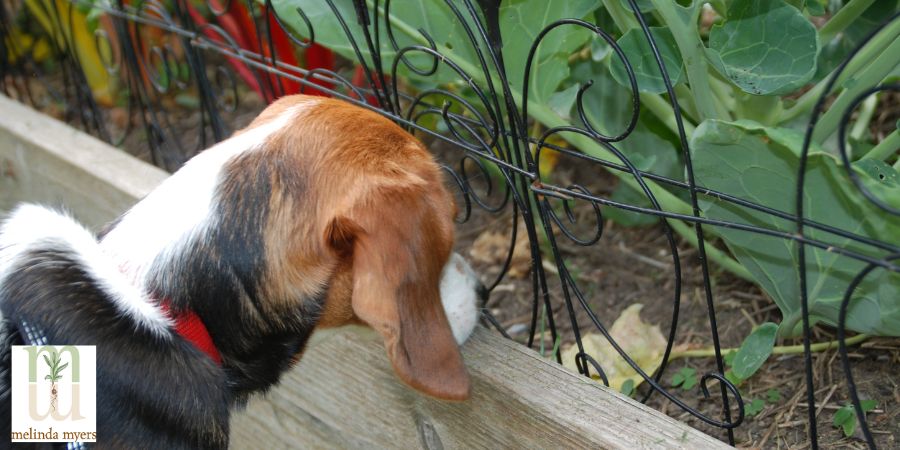
Fencing in all or part of the yard provides a secure space for your dogs to roam. A fenced yard reduces the risk of your dog darting out into the street, getting dognapped, or wandering off and getting lost. I realize this is ideal and may not always be possible. Always check with your Homeowners Association (HOA) and municipality for any fencing guidelines or restrictions. The last thing you want to do is install a fence that needs to be moved back from your lot line or removed.
Don’t fight your dog’s instinct to patrol the yard that creates running paths around or through the yard. Instead, give up this space to them and landscape around it. Grass usually does not survive the constant traffic, so cover the soil with pavers, flat stones, or mulch. This will help reduce the amount of mud they will track indoors during rainy weather.
Plant next to, not in, the running paths. Consider using durable ornamental grasses or shrubs to mask any unwanted views of the running paths.
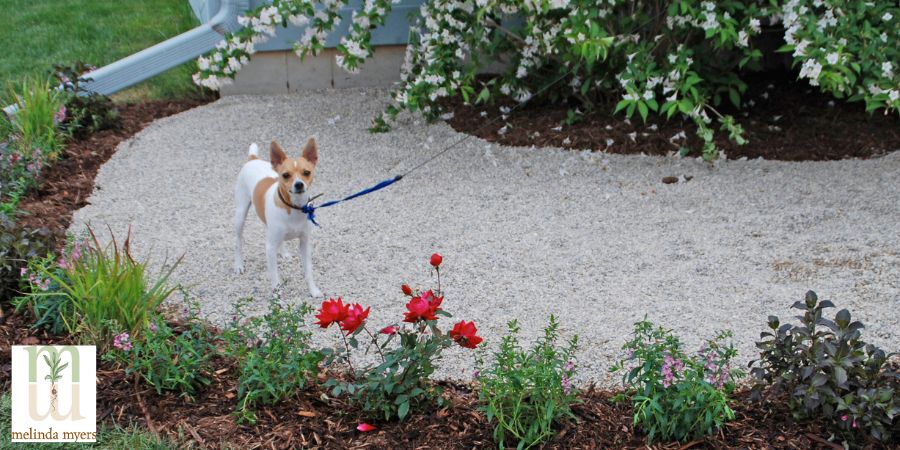
Plants that are Toxic to Dogs
Greatly reduce stress, avoid unnecessary vet bills, and keep your dog safe by only growing plants that are not toxic to dogs. The American Society for the Prevention of Cruelty to Animals (ASPCA) has an extensive list of plants that are toxic and non-toxic to dogs, cats, and horses. I also find the North Carolina Extension Gardener Plant Toolbox very helpful. Not only does it provide plant growing and care information, but also plant toxicity for people and pets. Your veterinarian and local Extension service are also useful resources.
Consider other plant features that can be harmful to your pet. Plants with thorns, prickles, and spines can injure an eye or get stuck in the paw of curious dogs. Avoid using these where dogs have easy access.
Start by making a list of the plants suitable to your growing conditions and garden design. Plants suited to the growing conditions will thrive and look great with less maintenance. Then check these resources to see if the plants are non-toxic and otherwise safe for your pet. Eliminate any that are toxic and look for suitable substitutes if necessary.
Watch for weeds, volunteer plants, and mushrooms that appear in your yard. Remove any of these plants that are toxic to your dog, are invasive, or outcompete your desirable plants for water and nutrients. Remove and discard mushrooms as soon as they appear in your garden. These are the fruiting structures of fungi living in the soil and feeding on decaying wood. Mushrooms usually appear after a rainy period and eventually cease being a problem once they have fully decomposed their underground food source.
Protecting Your Plants from Curious Dogs
We love our pets, but as gardeners, we also love our plants. Keep key plants and gardens safe with a bit of training, fencing, or raised beds.
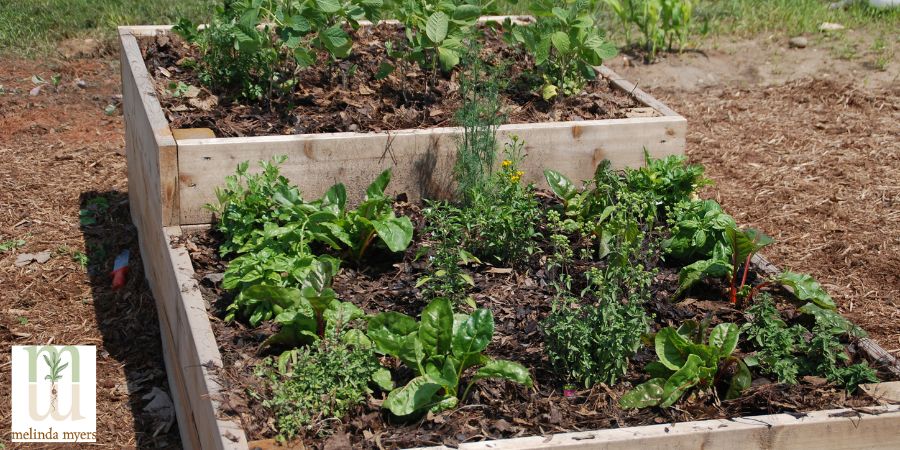
Teaching your dog a bit of garden etiquette is one option. Make sure everyone in the house is on board and use the same keyword to train your dog to stay out of the garden. Use a consistent command like “out” said in the same tone every time. This may be enough to redirect your dog. Then reward them once they are outside the garden.
A two feet high fence of chicken wire or decorative material may be enough to deter some dogs. Once they learn to avoid the space, you may be able to remove the fencing. You and your dog will need to make that decision.
Otherwise, raised beds may be the answer. Elevating your garden is easier on your knees and back and usually makes a less inviting space for your dog.
Selecting a Mulch Safe for Dogs
As a gardener, you know the value of mulch. Organic mulches conserve moisture, suppress weeds, moderate soil temperature, and improve and protect the soil. Dogs are notorious for chewing on things, including mulch. So, selecting a mulch that is safe for your dog and its habits is important.
Avoid cocoa bean shell mulch. Most dogs are attracted to the smell and this mulch contains the chemical theobromine which is toxic to dogs. The size of your dog and the amount they consume influences the way it affects your dog. Dogs consuming large amounts of cocoa mulch can experience vomiting, diarrhea, an increased heart rate, muscle tremors, seizures, and possibly death. Even a small amount can cause gastrointestinal complications. Contact your veterinarian immediately if you suspect your dog consumed some of this mulch.
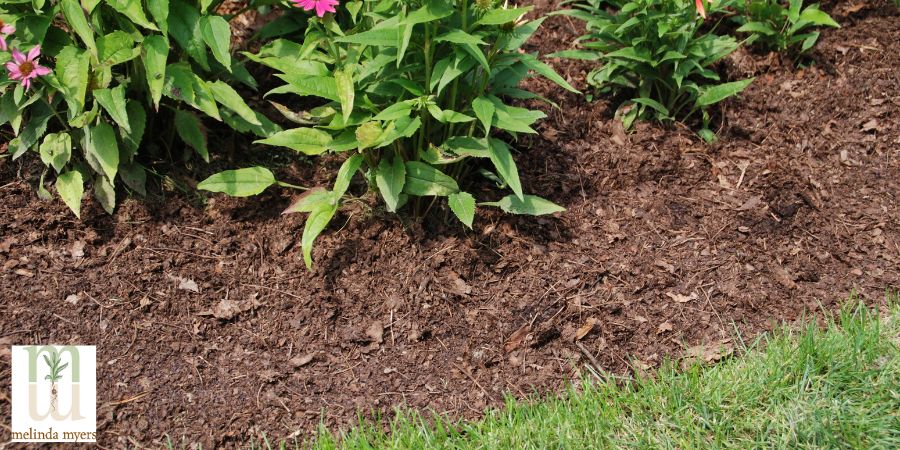
Compost, shredded pine, cedar, hemlock and shredded leaves are usually safer options. Avoid any mulch with pieces large enough to become lodged in the dog’s mouth or throat and, if swallowed are hard for them to digest. Do not use wood mulch made from treated lumber or those treated with weed inhibitors, pesticides, or other chemicals that may be harmful to your pet. Talk to your mulch provider when buying mulch in bulk and confirm that the product is safe for dogs. Check the label when buying bagged mulch. Look for mulches labeled as organic, safe for children and pets, and that contain the Mulch & Soil Council Certification.
Rock mulch may be a suitable option for some dogs. Select those small enough to avoid choking but large enough not to become lodged in their paws. Avoid this mulch option if your dog tends to chew on rocks.
Wear-tolerant and Urine-resistant Grasses for Dogs
Grass is a major component of many landscapes but often suffers from wear and tear and urine burn. Select the most wear-tolerant and urine-resistant grass variety suited to your climate.
Wear-Resistant Grasses
Bermuda grass is a good choice for those growing warm-season lawns. It is traffic tolerant and quick to recover from damage. Zoysiagrass also tolerates traffic but recovers more slowly.
For cool-season grasses turf-type tall fescues are the most wear resistant, followed by creeping red fescue, perennial rye, and Kentucky bluegrass. Turf-type tall fescue is a bunch-type grass and is slow to fill in bare spots that occur. Consider mixing it with another grass or Dutch white clover. This clover fills in more rapidly, is drought tolerant, and requires less frequent mowing. Dutch white clover alone or mixed with tall turf-type tall fescue makes a nice low-maintenance groundcover for pets and kids.
Best Grasses for Dog Urine
Urine spots are a common problem in lawns with dogs. The nitrogen and excess salts in the dog’s urine are usually blamed for the damage. The nitrogen can cause darker green spots, and the excess salts can damage the grass. Recent research found that lactic acid in the urine is the main cause of the dead spots and is similar to how a weed killer works.
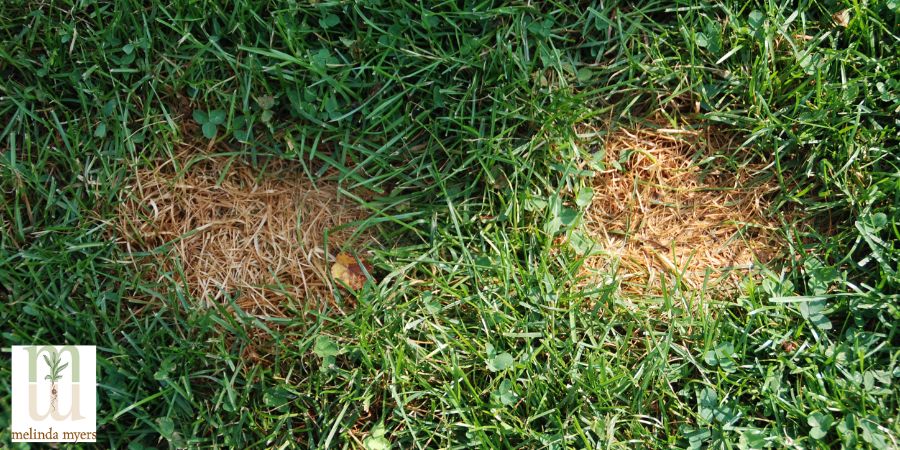
The amount of damage is influenced by your dog’s breed, sex, age, and size. Puppies and female dogs tend to squat to urinate, concentrating the urine in a smaller location. Male dogs urinate on trees, shrubs, posts, and other vertical structures and spray large areas, diluting the urine over a larger area. The larger the dog the more urine and potential for damage.
Bermudagrass and zoysiagrass are the most lactic acid tolerant warm-season grasses. Tall fescues are also the most lactic acid tolerant followed by creeping red fescue, perennial ryegrass, and Kentucky bluegrass.
Diluting the urine is one way to prevent the dead spots, but following your dog around with a watering can or hose is not very practical. Dog owners find the commercial products advertised to neutralize urine are not very effective.
You can speed up recovery by seeding the bare spots. Water the area thoroughly to dilute any remaining lactic acid out of the soil. Purchase a lawn patch kit or make your own by mixing a handful of grass seed in a mop bucket of planting mix. Sprinkle this over the bare spots and lightly rake. A colleague of mine keeps all the ingredients on hand to seed as needed throughout the growing season.
Avoid these dead spots in the lawn and contain the poop by training your dog to use a designated potty area. An eight-by-eight-foot area is usually sufficient for a medium size dog. Younger dogs may be easier to train than those used to using the whole yard for this purpose.
Many dog owners opt for pea gravel that does not retain odors, is easily washed, and the change of surface is a good cue for the dog to use this area. Artificial turf is another popular option. Select a convenient location for you and the dog and one out of the way of other backyard activities. Provide a vertical structure for male dogs. I have seen several people include faux fire hydrants.
Screen off the area and further delineate the space for the dog. Include an attractive mix of ornamental grasses, perennials, and shrubs that are safe for your dog and complement your landscape design.
Traditional Lawn Grass Alternatives
Dutch white clover makes a safe, drought-tolerant, and low-maintenance ground cover. Many people are growing clover lawns to support pollinators, including bees. It is hardy in zones 3 to 10 and prefers full sun to part shade and flowers in early summer.
Some dog owners have found Irish moss a suitable alternative to grass. It tolerates moderate traffic and is hardy in zones 4 to 8. It grows in full sun to part shade and is not toxic to dogs.
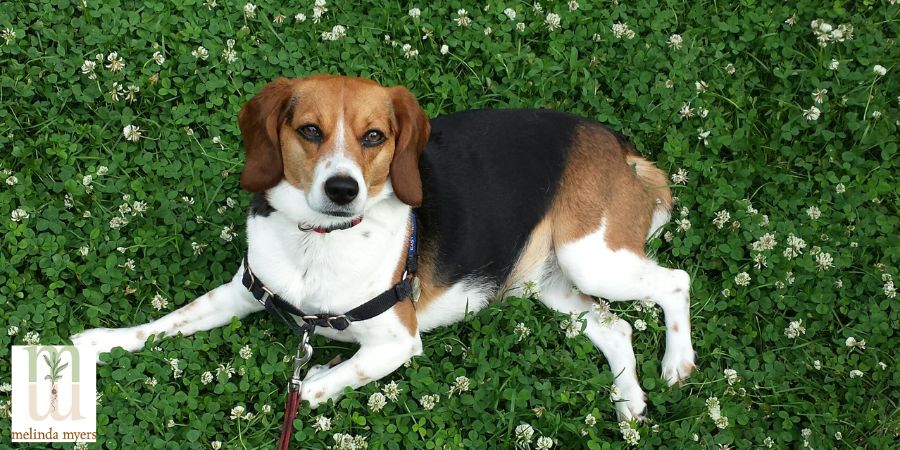
Creeping thyme is often used as a ground cover in sunny locations with well-drained soil. It tolerates moderate wear and is most often used in combination with pavers in landscape situations. Many gardeners are mixing this plant with fine fescue to create a bee lawn. The grass provides a more durable backdrop for the thyme.
All three of these attract pollinators, including bees. Most native bees are docile and do not sting but honeybees can and some wasps can be aggressive when threatened. Keep this in mind if your dog likes to chase flying things and eat bees or wasps. This is something to discuss with your veterinarian before installing this type of ground cover.
Some people are turning to synthetic turf. It has greatly improved in looks and durability over the past few decades. No fertilizer or watering is needed for this low-maintenance option. Proper installation is needed to create a durable, long-lasting, and good-looking synthetic lawn.
When planting grass or groundcovers consider doing it in sections. Confine your dog to one part of the yard while you get the grass or ground cover established in another area. Repeat until you get the whole area covered.
Safely Fertilizing Lawns and Gardens for Pets
Healthy soil is the best and safest way to grow healthy, beautiful, and productive gardens. Incorporating compost into compacted soil before planting or establishing a lawn can improve drainage in heavy soils, increase the water-holding ability in fast-draining soil and provide nutrients for the plants. Spreading a layer of compost over the soil surface or lawn is a way to add this valuable amendment and nutrients to existing gardens and landscapes.
You can make your own compost from insect- and disease-free plant trimmings and plant-based kitchen scraps. Do not include meat, bones, fat, perennial weeds, annual weeds gone to seed, and invasive plants. Keep your dog safe by keeping your compost pile out of their reach. Some of the common components of the compost pile like coffee, moldy food, and certain types of fruits and vegetables, are dangerous for your dog. Consider composting in an area where your dog cannot access the pile. Once decomposition is complete, compost makes a great soil amendment and mulch.
When opting for fertilizer, always read the label and follow the application directions. Any fertilizer, including natural and organic products, can be harmful if your dog eats it. Consider watering in the fertilizer and keeping your dog off the lawn for at least 24 hours when applying fertilizer to the lawn.
Milorganite fertilizer has been safely used on family lawns and gardens without harming children, pets, or the surrounding environment for more than 90 years. It is held to stricter standards than synthetic fertilizers and is kiln-dried at 900°F to kill pathogens.
Some dogs are attracted to the smell of Milorganite and will eat it. Eating large amounts of the course fertilizer pellets can cause gastroenteritis, irritation, and inflammation of the intestines and your dog may experience vomiting and diarrhea, leading to dehydration.
Avoid this problem by keeping Milorganite out of the reach of your dog. This is a good practice for any fertilizer or chemical. Reduce the temptation by watering right after applying Milorganite and keep your dog off the lawn and out of the gardens for 24 hours.
Stopping Pet's Destructive Behavior in the Yard
Digging, chewing on plants, and other behavior that damages the lawn and garden can be annoying. Boredom and excess energy are often the cause. Walks, visits to the dog park, and toys can help expend some of the excess energy and provide needed entertainment.
Provide a spot in the yard where the dog is allowed to dig. Some dog owners found providing a sandy spot in the yard or even a sandbox where the dog can dig solved the problem for them and the dog. Provide chew toys with hidden goodies and spray plants with bitter apple to dissuade them from chewing on plants and wood features in the landscape.
Keep them comfortable by providing some shade. Watch where your dog likes to lay in the sun or retreat into the shade. Add some shade if needed and provide some soft bedding like mulch and a bowl of water.
You know your dog and its behavior. Keep this and a discussion with your veterinarian in mind as you design the landscape of your dreams that is dog friendly.

